- 1School of Financial Management, Hainan College of Economics and Business, Haikou, China
- 2Department of Economics and Finance, The Hang Seng University of Hong Kong, Hong Kong, SAR China
- 3School of Finance, Yunnan University of Finance and Economics, Kunming, China
In this paper, a nonparametric kernel prediction algorithm in machine learning is applied to predict CO2 emissions. A literature review has been conducted so that proper independent variables can be identified. Traditional parametric modeling approaches and the Gaussian Process Regression (GPR) algorithms were introduced, and their prediction performance was summarized. The reliability and efficiency of the proposed algorithms were then demonstrated through the comparison of the actual and the predicted results. The results showed that the GPR method can give the most accurate predictions on CO2 emissions.
Introduction
As the population of the earth is being exponentially increasing, the exhaustion of carbon dioxide is increasing day by day resulting in the extreme overheating of the environment, which has become a significant reason for climate change. Global efforts to mitigate climate change were focused on the reduction of future days with extreme overheating of the environment. There are many research and surveys that have been conducted by various scientists, students, and other officials which were about the reasons for the high emission of CO2 in different countries. Most of the empirical studies took the parametric modeling approach to analyze the factors that initiate and support the emission of CO2. However, the traditional parametric approach optimizes a function to a known form with a set of finite and pre-determined parameters. This rigidity limits the predictive power of the parametric models. In recent years, nonparametric machine learning techniques have played dominantly with the enhancement of the forecast.
In this paper, a Bayesian nonparametric kernel prediction algorithm in machine learning is applied to predict CO2 emissions. A literature review has been conducted so that the proper independent variables have been identified. Classical least squares, robust least squares, and algorithms of the GPR were introduced and their prediction performance, including the evaluation criteria that are effective in the measurements for model performance, were summarized. The reliability and efficiency of the proposed algorithms were then demonstrated through the comparison between the actual data and the predicted results. It is found that GPR can give the most accurate predictions on CO2 emissions.
Literature Review
The growth of the economy, energy utilization, and CO2 emissions are deeply related to each other. Kolstad and Krautkraemer (1993) point out that while the use of resources like the energy has a bright side on growth, it has negative environmental impacts. Traditional growth theories like the Solow growth model failed to consider the environmental impacts of growth (Solow, 1956). More modern growth theories study the interrelationship among energy, the environment, and economic growth (see, for example, Kolstad and Krautkraemer (1993), Jorgenson and Wilcoxen (1993) or Xepapadeas (2005) for a brief review).
Empirical studies depict that the growth of the economy and the ingestion of energy incorporates with the process of CO2 emission. Recently, Hu et al. (2020) study the dominant reasons for carbon emission among the Belt and Road countries and find that CO2 emissions have increased significantly due to economic growth. Similarly, Shabaz et al. (2013) found that in Indonesia, the emission of CO2 increased for the extreme boost of the economic zone, while Shahbaz et al. (2016) found that economic growth led to CO2 emissions in Bangladesh and Egypt. Meanwhile, other studies discovered a bilateral causal relationship among the three variables. Munir et al. (2020) prove the fact that there is a relation of aftermaths and economy between GDP and energy ingestion in the major countries of the ASEAN (Association of Southeast Asian Nations), while Liu and Hao (2018) find that in energy-exporting countries, there is a bilateral relationship which may be a full-duplex connection between CO2 emissions, energy utilization, and GDP per capita. Similarly, a repeating loop effect is observed between energy ingestion, CO2 emission, and the advancement of the economy by Kahouli (2018). Accordingly, Mohmannd et al. (2020) observed the working principle of the causal relationship among transportation infrastructure, economic growth, and transportation emissions from 1971 to 2017 in Pakistan. The results show short-term causality from transportation infrastructure, economic growth, fuel consumption to CO2 emissions, and the long-run relationship between economic advancement and infrastructure.
Apart from the growth and energy consumption, industrialization, population growth, and income level also contributed a great share in global carbon emissions. Minx et al. (2011) found that “industrialization” can be taken into consideration for the rapid increase of carbon dioxide emission in China from 2002 to 2007 while Zhang et al. (2014) found that the growth of the tertiary industry can decrease the CO2 exhalation intensity. Nasir et al. (2021) examined the connection between the factors which are the exhalation of CO2, industrialization, growth of the economy, energy ingestion, and several connecting factors from 1980 to 2014 in Australia. The observations of those involved say that all variables affect CO2 emissions. Li et al. (2021) discussed the effect of the growth and structure of the economy on per capita CO2 emissions in 147 countries from 1990 to 2015. The results show that at the global level, economic growth and economic structure are the most significant positive and positive effects, respectively.
Studies on population have thus far concentrated on the relationship between population growth and emission increase. The effect of population growth on CO2 emissions can be summarized as follows (Birdsall, 1992): On one side, the energy demand was increased for power generation, industry, and transport. On the contrary, it increased deforestation emissions due to population growth. Empirically, Knapp and Mookerjee (1996) conducted a Granger causality test on annual data from 1880 to 1989 to determine the connecting clauses between global population expansion and carbon dioxide exhaustion. The results show there is a short-term dynamic relationship between the exhaustion of carbon dioxide and population growth. Very recently, Zhang et al. (2020) analyzed the knot between CO2 emissions, GDP, and fuel ingestion in China and ASEAN countries. It was found that carbon density, energy intensity, GDP, and population are positively correlated with CO2 emissions. Empirical findings also show that the developing countries are facing the effect of overpopulation and that’s why, they are facing more of a carbon emissions record per year other than the developed countries (Shi, 2003).
In the past decade, the theory and methodology of the Environmental Kuznets Curve (EKC) have been used to analyze the relationship between the net income and exhaustion of carbon of an area (Dinda, 2004; Williams and Rasmussen, 1996). According to the EKC, at relatively low-income levels, emissions increase as income increases. After a certain point, emissions will decline with income. Thus, the emission of CO2 varies concerning the level of income. Luo et al. (2021) investigated the influencing factors of Shanghai’s CO2 emissions from 1995 to 2017. They found that personal disposable income is one of the top drivers of CO2 emissions. Yuan et al. (2014) examined the long-term relationship between China’s per capita income, ingestion of energy, and the emission of CO2 from 1953 to 2008. They found out, there is a unilateral Granger inter-relation between the gross national income and the emission of CO2.
Based on the literature above, it concludes that economic up-gradation, energy utilization, manpower density, industrialization, and income can be classified as the predominant factors affecting CO2 emissions. Other factors might also affect CO2 emissions in China. For example, R&D (Nguyen et al., 2020; Jones, 1995), financial development (Bhattacharya et al., 2017; Zaidi et al., 2019; Wang et al., 2020), the degree of foreign direct investment (Essandoh et al., 2020; Le et al., 2020; Khan and Rana, 2021. etc). This paper limits the focus on how well the different prediction models perform based on the information set which includes only the most predominant driver of CO2 emissions and excludes those unimportant ones to be captured by the stochastic terms in the models.
Methodology
Gaussian Process Regression (GPR) method can be introduced as a non-parametric Bayesian regression method (Gershman and Blei, 2012). It captures a wide variety of relations between inputs and outputs and lets the data determine the complexity of the underlying functions through the means of Bayesian inference (Williams, 1998). Considering the output
In classical linear regression,
where
A finite collection of function values sampled from the Gaussian process follows multiple Gaussian distributions:
where
Here,
The covariance function determines the characteristics of the Gaussian method that can be expressed as
where
More details about the regression process of Gaussian can be researched and acknowledged in the book of Williams and Rasmussen (2006), available free online and is accessible via the link: www.GaussianProcess.org/gpml.
Empirical Results
A literature review has been conducted so that five independent variables; namely: economic growth, energy consumption, population, industrialization, and income, have been identified. In this study, the GPR method and the other proposed algorithms are applied to study carbon emissions in China. Economic growth is approximated by GDP (100 million RMB), energy consumption is approximated by per capita energy consumption (tons of standard coal), the population is approximated by population size (10,000 people), industrialization is weighted by the percentage of secondary industry in China, and income is measure by the average annual salary (RMB).
The data of GDP, population size, energy consumption, percentage of secondary industry, and average annual salary are collected from the China City Statistical Yearbook. CO2 emissions data come from four main sources of energy consumption. These are electricity, fuel, heating, and transportation. Those data can be obtained and calculated through the China Urban Construction Statistical Yearbook, the China City Statistical Yearbook, and the submerged government Panel on the change of weather and climate. Since some of those data is not available after 2014, the data in this paper range from the year 2002–2014.
Statistical Analysis of Prediction Results
The commonly used criteria in prediction performance are used in this study to evaluate the validity of the fitting. In Table 1, the root means squared error (RMSE), the mean squared error (MSE), the R-square, and the mean absolute error (MSE) are shown, where a well-fitted model should have R-square close to 1, whereas the RMSE, the MSE, and the MAE should be as small as possible. As per the observation from Table 1, Exponential GPR provides the best fit data as it has the smallest RMSE, MSE, and MAE, and an R-square closest to 1.
Data Visualization
Since the data set is large, which made it difficult to demonstrate and view the whole set of data, visualization methods are typically needed especially for representative scenarios. The prediction results were analyzed at the model level to see the allover authenticity of the three models and at the individual component level to get a picture of the estimates produced by the three models over the range of some particular variable.
At the overall level, the comparison and deviation of the actual value and the predicted dimension of the emission of carbon dioxide are determined. Figure 1 demonstrates the comparison of actual value and prediction of CO2 emissions predicted by the three models; for each model, the predicted value is plotted against the actual value. To have a good fit, each plot should resemble a straight line at 45°. However, compare with the exponential GPR model, for the classical least squares model and the robust least-squares model, the predicted values are larger than the actual values over the range of 3.5–4 logarithm units of CO2 emissions. This means that the classical least squares model and the robust least-squares model are overestimating CO2 emissions over a particular range compare with the exponential GPR model. The same issue can be observed from Figure 2 which shows the deviation of actual value and prediction of CO2 emissions for the three models. Figure 2 shows that, compare with the other two models, the deviations for the exponential GPR model cluster more closely around the horizontal line which represents no deviations. It suggests that the exponential GPR model provides a much better fit than the other two models.
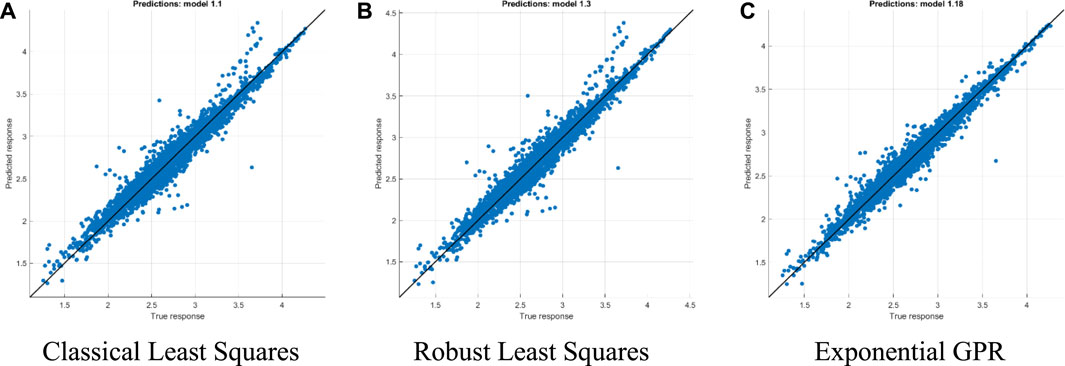
FIGURE 1. Comparison of actual value and prediction of CO2 emissions between the selected models. (A) Classical Least Squares. (B) Robust Least Squares. (C) Exponential GPR. Notes: 1) The horizontal axis represents actual CO2 emissions in logarithm, and the vertical axis represents predicted CO2 emissions in logarithm. 2) CO2 emissions are measured in ten thousand tons of standard coal.
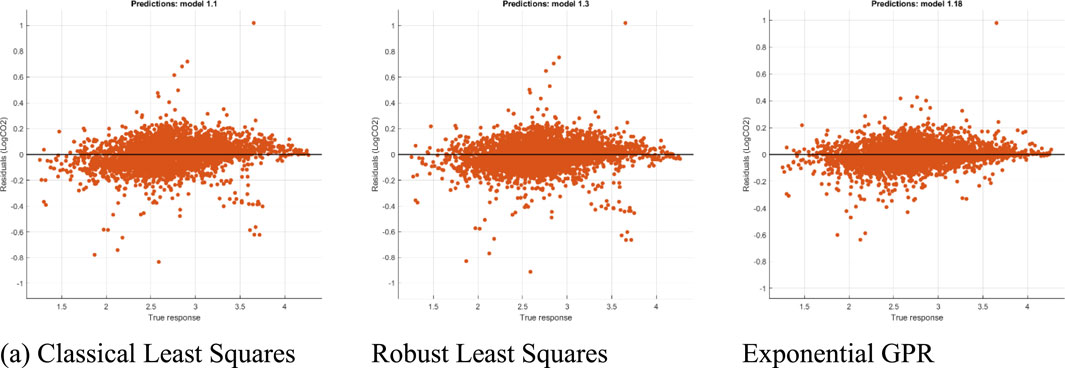
FIGURE 2. The deviation of actual value and prediction of CO2 emissions between the selected models. (A) Classical Least Squares, Robust Least Squares, Exponential GPR. Notes: 1) The horizontal axis represents actual CO2 emissions in logarithm, and the deviation of the actual extremity of the CO2 emission from the predicted value is represented by the vertical axis. 2) CO2 emissions are measured in ten thousand tons of
Apart from analyzing the prediction results at the overall model level, the all over performance of the three models is also be evaluated at an individual component level. At the individual component level, the estimates produced by the selected models are analyzed over the extended range of some particular variables. Figures 3–7 below plot the actual and predicted values of CO2 emissions against each of the most predominant factors of the models.
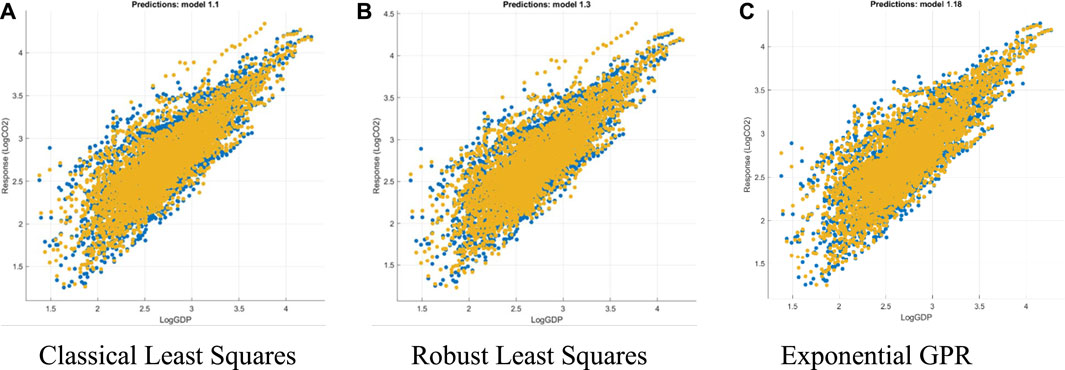
FIGURE 3. Comparing actual and predicted CO2 emissions against GDP of the selected models. (A) Classical Least Squares. (B) Robust Least Squares. (C) Exponential GPR. Notes: 1) The vertical axis denotes the value of CO2 emissions in the logarithm. 2) The horizontal axis denotes the value of GDP in logarithm. 3) CO2 emissions are measured in 10,000 tons of standard coal. 4) The blue dots represent actual values whereas the yellow dots represent the predicted values. (5) GDP is measured in 100 million Chinese Yuan.
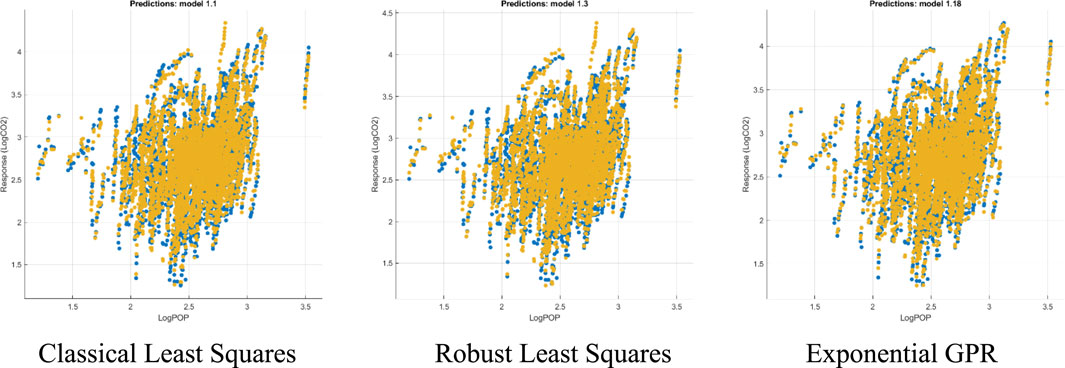
FIGURE 4. Comparing actual and predicted CO2 emissions against population size of the selected models. Classical Least Squares, Robust Least Squares, Exponential GPR. Notes: 1) The vertical axis represents the value of CO2 emissions in logarithm. 2) The horizontal axis represents the population size in logarithm. 3) CO2 emissions are measured in 10,000 tons of standard coal. 4) The blue dots represent actual values whereas the yellow dots represent the predicted values. 5) The unit of population is 10,000 people.
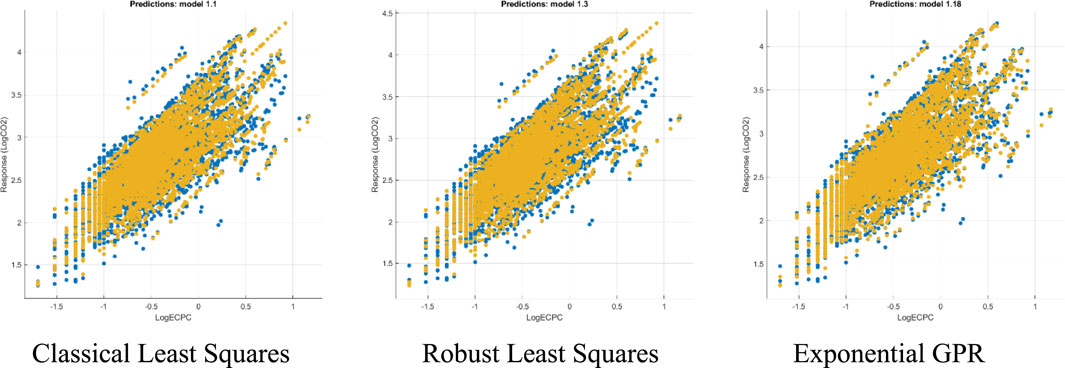
FIGURE 5. Comparing actual and predicted CO2 emissions against energy consumption of the selected models. Classical Least Squares, Robust Least Squares, Exponential GPR. Notes: 1) The vertical axis represents the value of CO2 emissions in logarithm. 2) The horizontal axis represents the value of per capita energy consumption in a logarithm. 3) CO2 emissions are measured in 10,000 tons of standard coal. 4) The blue dots represent actual values whereas the yellow dots represent the predicted values. 5) Per capita energy consumption is measured in tons of standard coal.
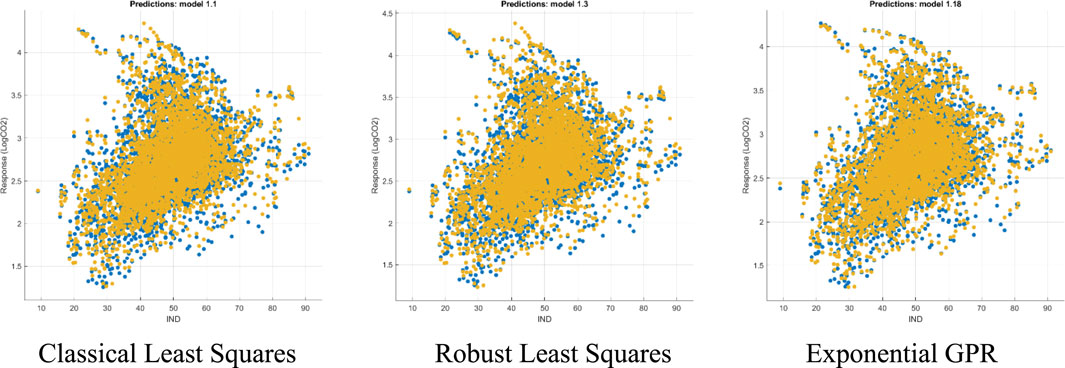
FIGURE 6. Comparing actual and predicted CO2 emissions against the industrialization of the selected models. Classical Least Squares, Robust Least Squares, Exponential GPR. Notes: 1) The vertical axis represents the value of CO2 emissions in logarithm. 2) The horizontal axis represents the percentage of secondary industry in China. 3) The blue dots represent actual values whereas the yellow dots represent the predicted values. 4) CO2 emissions are measured in 10,000 tons of standard coal.
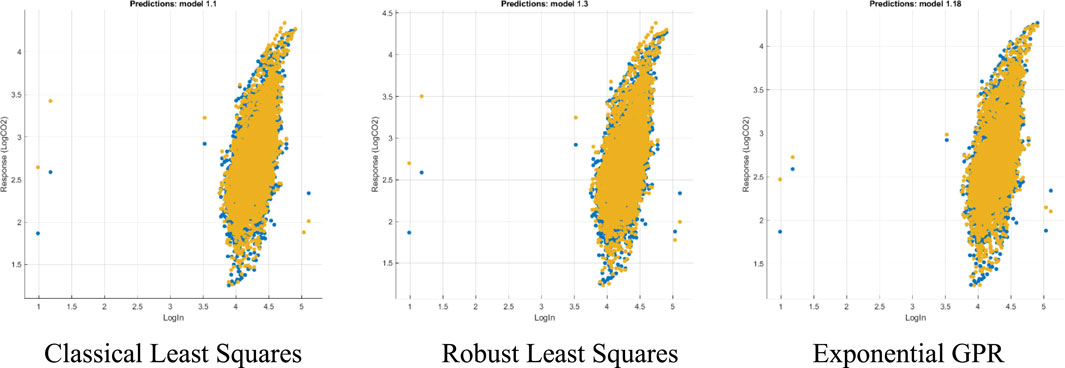
FIGURE 7. Comparing actual and predicted CO2 emissions against average annual salary of the selected models. Classical Least Squares Robust Least Squares Exponential GPR Notes: 1) The vertical axis represents the value of CO2 emissions in logarithm. 2) The horizontal axis represents the average annual salary in logarithm. 3) CO2 emissions are measured in 10,000 tons of standard coal. 4) The blue dots represent actual values whereas the yellow dots represent the predicted values. 5) Average annual salary is measured in the Chinese Yuan.
Figure 3 plots the predicted values of CO2 emissions against the logarithm of the GDP measured in 10,000 Chinese Yuen. Ideally, it’s convenient if the predicted values are as much closer possible to the actual values for all conducted observations. As shown in Figure 3C predicted CO2 emissions are quite close to the actual values predicted by using the logarithm of GDP. Even though a small number of deviations can be observed. On the contrary, Figures 3A,B revealed that the classical least squares and the robust least-squares overestimate the CO2 emissions over the range of 3.2–3.7 logarithm units of GDP. It implies that conditioning on GDP, the Exponential GPR model provides more accurate CO2 emissions predictions compare with the other two models.
Figures 4–6 show similar results. The predicted CO2 emissions by using the exponential GPR model are tensed to the actual values over the entire range of population size (see Figure 4), the energy consumption (see Figure 5), and the level of industrialization (see Figure 6). However, when the classical least squares and the robust least-squares model are used, extreme deviations between the actual value and predicted value can be observed. In Figures 4A,B, it is determined that the classical least squares and the robust least-squares model overestimate the CO2 emissions over the range of 2.7–2.8 logarithm units of population size. Similarly, in Figures 5A,B, CO2 emissions are overestimated by the classical least squares and the robust least squares models over the range of 0.5–1 logarithm units of per capita energy consumption. In Figure 6, although not obvious, CO2 emissions are overestimated by the classical least squares and the robust least squares models over the range of 40–50% of secondary industry in China.
Figure 7 shows how the predicted values deviate from the actual values when the independent variable is non-Gaussian for the presence of threshold data points from extreme references. As with the evidence presented above, extreme upward bias over a particular range can be observed when the classical least squares and the robust least squares are used; the models overestimated CO2 emissions over the range of 4.5– to 4.75 logarithm units of average annual salary. The extreme bias disappears when the exponential GPR model is used. Moreover, when the exponential GPR model is used, the deviations between the actual values and the predicted values are smaller for the extreme data values observed over the range of 1– to 1.5 and 5 to 5.5 logarithm units of average annual salary.
In summary, Figures 3–7 show that predicted CO2 emissions conditional on individual components (i.e., GDP, population size, energy consumption, and industrialization) are quite close to the actual values predicted using the exponential GPR model. Even the underlying distribution of the independent variable is non-Gaussian. Meanwhile, extreme upward bias per component in the technique can be observed when the classical least squares and the robust least squares models are used. Thus, a conclusion may be drawn upon the study that the exponential GPR model gives the most accurate predictions on CO2 emissions compared with the remaining models.
Conclusion and Future Works
In this paper, the Gaussian process regression method is proposed for CO2 emissions analysis in China. The traditional linear regression approach is limited by its rigid functional form and the approach often encounters an over-fitting problem. The Gaussian progress regression approach relaxes the parametric assumption by applying the Bayesian nonparametric inference approach. The preciseness and exactitude of the prediction of the exponential GPR were compared and discussed with the classical least squares and the robust least-squares model. Based on the outcome of the whole study, it is proved that the Gaussian progress regression algorithms can give the most accurate predictions on CO2 emissions compared with the other two traditional models and thus is applicable for CO2 emissions prediction analysis to enhance forecast performance.
The prediction performances of the selected methods discussed only focus on the six predominant factors affecting carbon emissions. Future research should focus on further reviewing the completeness of the set of driving factors and the effectiveness of model predictions, compared them with other commonly used models.
Data Availability Statement
The raw data supporting the conclusions of this article will be made available by the authors, without undue reservation.
Author Contributions
NM proposed the conceptualization, methodology and funding acquisition. WS gave the formal data analysis and wrote the original formal draft. TH performed the data collection and original arrangement. FL gave formal methodology, writing-review and editing.
Funding
This study was supported by Hainan College of Economics and Business (Project Reference Number: hnjmk2021301) and the Scientific Research Foundation of Yunnan University of Finance and Economics (No. 2020B03).
Conflict of Interest
The authors declare that the research was conducted in the absence of any commercial or financial relationships that could be construed as a potential conflict of interest.
Publisher’s Note
All claims expressed in this article are solely those of the authors and do not necessarily represent those of their affiliated organizations, or those of the publisher, the editors, and the reviewers. Any product that may be evaluated in this article, or claim that may be made by its manufacturer, is not guaranteed or endorsed by the publisher.
References
Bhattacharya, M., Rafiq, S., Lean, H. H., and Bhattacharya, S. (2017). The Regulated Coal Sector and CO2 Emissions in Indian Growth Process: Empirical Evidence over Half a century and Policy Suggestions. Appl. Energ. 204, 667–678. doi:10.1016/j.apenergy.2017.07.061
Birdsall, N. (1992). Another Look at Population and Global Warming. In Policy Research Working Papers ; No. WPS 1020. Population, Health, and Nutrition, 1020. Retrieved from http://documents.worldbank.org/curated/en/985961468766195689/Another-look-at-population-and-global-warming.
Dinda, S. (2004). Environmental Kuznets Curve Hypothesis: A Survey. Ecol. Econ. 49 (4), 431–455. doi:10.1016/j.ecolecon.2004.02.011
Essandoh, O. K., Islam, M., and Kakinaka, M. (2020). Linking International Trade and Foreign Direct Investment to CO2 Emissions: Any Differences between Developed and Developing Countries?. Sci. Total Environ. 712, 136437. doi:10.1016/j.scitotenv.2019.136437
Gershman, S. J., and Blei, D. M. (2012). A Tutorial on Bayesian Nonparametric Models. J. Math. Psychol. 56 (1), 1–12. doi:10.1016/j.jmp.2011.08.004
Hu, M., Li, R., You, W., Liu, Y., and Lee, C.-C. (2020). Spatiotemporal Evolution of Decoupling and Driving Forces of CO2 Emissions on Economic Growth along the Belt and Road. J. Clean. Prod. 277, 123272. doi:10.1016/j.jclepro.2020.123272
Jones, C. I. (1995). R & D-Based Models of Economic Growth. J. Polit. Economy 103 (4), 759–784. doi:10.1086/262002
Jorgenson, D. W., and Wilcoxen, P. J. (1993). Reducing U.S. Carbon Dioxide Emissions: an Assessment of Different Instruments. J. Pol. Model. 15 (5-6), 491–520. doi:10.1016/0161-8938(93)90003-9
Kahouli, B. (2018). The Causality Link between Energy Electricity Consumption, CO2 Emissions, R&D Stocks and Economic Growth in Mediterranean Countries (MCs). Energy 145, 388–399. doi:10.1016/j.energy.2017.12.136
Khan, M., and Rana, A. T. (2021). Institutional Quality and CO2 Emission-Output Relations: The Case of Asian Countries. J. Environ. Manage. 279, 111569. doi:10.1016/j.jenvman.2020.111569
Knapp, T., and Mookerjee, R. (1996). Population Growth and Global CO2 Emissions. Energy Policy 24 (1), 31–37. doi:10.1016/0301-4215(95)00130-1
Kolstad, C. D., and Krautkraemer, J. A. (1993). “Natural Resource Use and the Environment,”. In Handbook of Natural Resource and Energy Economics. Editors A. V. Kneese, and J. L. Sweeney. 1st ed. Amsterdam North Holland, 3, 1219–1265. doi:10.1016/s1573-4439(05)80013-2
Li, R., Wang, Q., Liu, Y., and Jiang, R. (2021). Per-capita Carbon Emissions in 147 Countries: The Effect of Economic, Energy, Social, and Trade Structural Changes. Sustainable Prod. Consumption 27, 1149–1164. doi:10.1016/j.spc.2021.02.031
Liu, Y., and Hao, Y. (2018). The Dynamic Links between CO2 Emissions, Energy Consumption and Economic Development in the Countries along "the Belt and Road". Sci. Total Environ. 645, 674–683. doi:10.1016/j.scitotenv.2018.07.062
Luo, Y., Zeng, W., Hu, X., Yang, H., and Shao, L. (2021). Coupling the Driving Forces of Urban CO2 Emission in Shanghai with Logarithmic Mean Divisia index Method and Granger Causality Inference. J. Clean. Prod. 298, 126843. doi:10.1016/j.jclepro.2021.126843
Mackay, D. J. C. (1998). Introduction to Gaussian Processes. In Neural Networks and Machine Learning. Berlin: Springer.
Minx, J. C., Baiocchi, G., Peters, G. P., Weber, C. L., Guan, D., and Hubacek, K. (2011). A "Carbonizing Dragon": China's Fast Growing CO2 Emissions Revisited. Environ. Sci. Technol. 45 (21), 9144–9153. doi:10.1021/es201497m
Mohmand, Y. T., Mehmood, F., Mughal, K. S., and Aslam, F. (2020). Investigating the Causal Relationship between Transport Infrastructure, Economic Growth and Transport Emissions in Pakistan. Res. Transportation Econ., 100972. doi:10.1016/j.retrec.2020.100972
Munir, Q., Lean, H. H., and Smyth, R. (2020). CO2 Emissions, Energy Consumption and Economic Growth in the ASEAN-5 Countries: A Cross-Sectional Dependence Approach. Energ. Econ. 85, 104571. doi:10.1016/j.eneco.2019.104571
Nasir, M. A., Canh, N. P., and Lan Le, T. N. (2021). Environmental Degradation & Role of Financialisation, Economic Development, Industrialisation and Trade Liberalisation. J. Environ. Manage. 277, 111471. doi:10.1016/j.jenvman.2020.111471
Nguyen, T. T., Pham, T. A. T., and Tram, H. T. X. (2020). Role of Information and Communication Technologies and Innovation in Driving Carbon Emissions and Economic Growth in Selected G-20 Countries. J. Environ. Manage. 261, 110–162. doi:10.1016/j.jenvman.2020.110162
Shahbaz, M., Hye, Q. M. A., Tiwari, A. K., and Leitão, N. C. (2013). Economic Growth, Energy Consumption, Financial Development, International Trade and CO2 Emissions in Indonesia. Renew. Sustain. Energ. Rev. 25, 109–121. doi:10.1016/j.rser.2013.04.009
Shahbaz, M., Mahalik, M. K., Shah, S. H., and Sato, J. R. (2016). Time-varying Analysis of CO2 Emissions, Energy Consumption, and Economic Growth Nexus: Statistical Experience in Next 11 Countries. Energy Policy 98, 33–48. doi:10.1016/j.enpol.2016.08.011
Shi, A. (2003). The Impact of Population Pressure on Global Carbon Dioxide Emissions, 1975-1996: Evidence from Pooled Cross-Country Data. Ecol. Econ. 44 (1), 29–42. doi:10.1016/s0921-8009(02)00223-9
Solow, R. M. (1956). A Contribution to the Theory of Economic Growth. Q. J. Econ. 70 (1), 65–94. doi:10.2307/1884513
Wang, R., Mirza, N., Vasbieva, D. G., Abbas, Q., and Xiong, D. (2020). The Nexus of Carbon Emissions, Financial Development, Renewable Energy Consumption, and Technological Innovation: What Should Be the Priorities in Light of COP 21 Agreements?. J. Environ. Manage. 271, 111027. doi:10.1016/j.jenvman.2020.111027
Williams, C. K. (1998). Learning in Graphical Models. Dordrecht ; Boston: Kluwer Academic Publishers. doi:10.1007/978-94-011-5014-9_23Prediction with Gaussian Processes: From Linear Regression to Linear Prediction and beyond
Williams, C. K., and Rasmussen, C. E. (2006). Gaussian Processes for Machine Learning. Cambridge, Mass: Mit Press.
Williams, C. K., and Rasmussen, C. E. (1996). Gaussian Processes for Regression. In Advances in Neural Information Processing Systems. Cambridge, MassLondon: Mit Press.
Xepapadeas, A. (2005). “Chapter 23 Economic Growth and the Environment,”. Economywide and International Environmental Issues. Editors Karl-GöranM., and J. R. Vincent (Amsterdam: North Holland), 3, 1219–1271. doi:10.1016/s1574-0099(05)03023-8
Yuan, J., Xu, Y., and Zhang, X. (2014). Income Growth, Energy Consumption, and Carbon Emissions: The Case of China. Emerging Markets Finance and Trade 50, 169–181.
Zaidi, S. A. H., Zafar, M. W., Shahbaz, M., and Hou, F. (2019). Dynamic Linkages between Globalization, Financial Development and Carbon Emissions: Evidence from Asia Pacific Economic Cooperation Countries. J. Clean. Prod. 228, 533–543. doi:10.1016/j.jclepro.2019.04.210
Zhang, J., Fan, Z., Chen, Y., Gao, J., and Liu, W. (2020). Decomposition and Decoupling Analysis of Carbon Dioxide Emissions from Economic Growth in the Context of China and the ASEAN Countries. Sci. Total Environ. 714, 136649. doi:10.1016/j.scitotenv.2020.136649
Keywords: Gaussian process regression, CO2 emissions, energy consumption, economics growth, industralization
Citation: Ma N, Shum WY, Han T and Lai F (2021) Can Machine Learning be Applied to Carbon Emissions Analysis: An Application to the CO2 Emissions Analysis Using Gaussian Process Regression. Front. Energy Res. 9:756311. doi: 10.3389/fenrg.2021.756311
Received: 10 August 2021; Accepted: 08 September 2021;
Published: 24 September 2021.
Edited by:
Xunpeng (Roc) Shi, University of Technology Sydney, AustraliaReviewed by:
Manman Yuan, University of Science and Technology Beijing, ChinaJunCheng Li, Chinese Academy of Social Sciences, China
Copyright © 2021 Ma, Shum, Han and Lai. This is an open-access article distributed under the terms of the Creative Commons Attribution License (CC BY). The use, distribution or reproduction in other forums is permitted, provided the original author(s) and the copyright owner(s) are credited and that the original publication in this journal is cited, in accordance with accepted academic practice. No use, distribution or reproduction is permitted which does not comply with these terms.
*Correspondence: Fujun Lai, bGZqbGZqOTk5QDE2My5jb20=
 Ning Ma
Ning Ma Wai Yan Shum
Wai Yan Shum Tingting Han
Tingting Han Fujun Lai
Fujun Lai